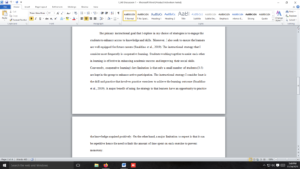Systematic planning process
- What are the primary types of information used to analyze learners? How do you, or could you, use this information in the systematic planning process for learning and for media selection?
- Smaldino et al. explain ten common types of instructional strategies. Which of these do you use most frequently and which less frequently? What instructional purpose (or goals) did you want to achieve? What advantages and limitations have you experienced when integrating each strategy?
- Bates describes the SECTIONS model for choosing and using media (and the technology used to support the media) in education. Compare the SECTIONS model with Smaldino et al.’s “Select Resources” step and selection rubric criteria from the ASSURE model. What do you see as limitations and possibilities of each set of criteria from each model for media selection?
Reading and Resources
- Readings from Smaldino et. al
- Chapters 1, 2, 3, and 4
- Table 3.2 “The Helpful Hundreds” from Smaldino et al. p. 45
- Figure 3.1 ABCD Objectives Checklist from Smaldino et al. p. 46
- ASSURE Lesson Plan Template from Smaldino et al. p. 62
- Bates Chapters 8 and 9
Bates, A. W. (2019). Teaching and learning in a digital age: Guidelines for designing, teaching, and learning (2nd ed.). https://pressbooks.bccampus.ca/teachinginadigitalagev2/ - Videos: Introduction to instructional media, ASSURE, and instructional systems (you are encouraged to follow the captions and/or the transcripts of the videos)
- Web resources
-
- Revised Bloom’s Taxonomy, from Iowa State University (Links to an external site.)
- Instructional Objectives—Instructional Systems Development (you need to sign in to NSU library) (Links to an external site.)
- The Best Resources For Helping Teachers Use Bloom’s Taxonomy In The Classroom (Links to an external site.)
- Bloom et al.’s Taxonomy of the Cognitive Domain (Links to an external site.) (Dr. William G. Huitt, Valdosta State University)
Requirements: 3 paragraph
Answer preview
The ASSURE model explained by Smaldino et al. (2019) informs choosing instructional strategies and resources needed to achieve the desired outcome. Similarly, the SECTIONS model described by Bates et al. (2019) criteria for effective choice of media for teaching and learning. Both ASSURE and SECTIONS inform the need for active decisions making process to integrate the choice into a broader course design. The possibility of using the SECTIONS model is to have a technology that incorporates the diverse interests and needs of the learners. However, this model is complex since it requires an extensive evaluation of each criterion to inform decisions (Bates et al., 2019). The ASSURE model informs the overall planning goals in using technology and media to deliver the desired outcome.
[483 Words]

Systematic planning process

